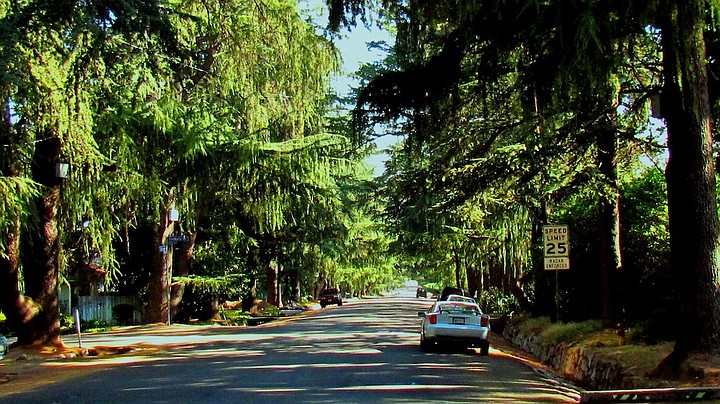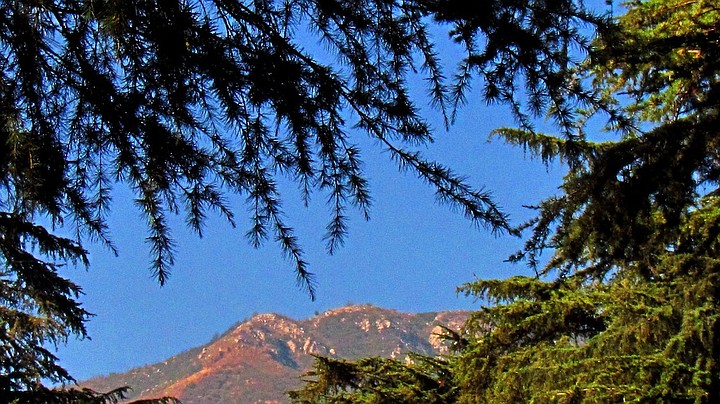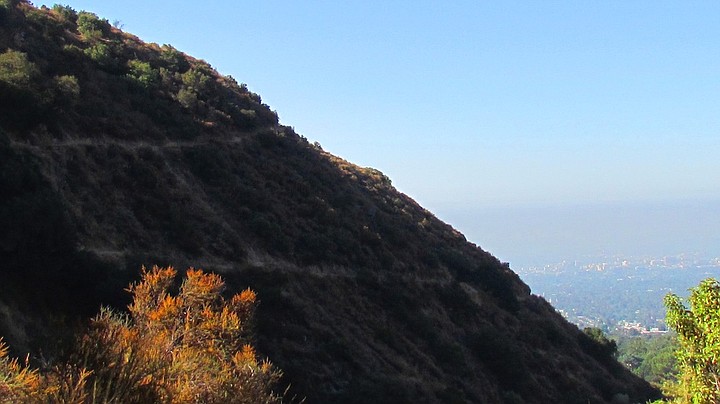 Facebook
Facebook
 X
X
 Instagram
Instagram
 TikTok
TikTok
 Youtube
Youtube

Author Zane Grey said, "In Altadena I have found those qualities that make life worth living."
Walking down Mariposa Street, “Millionaire’s Row,” where Grey’s home still stands – past the oversized craftsman-style bungalows and through Janes Village, the English cottage-style homes set back behind fences and overgrown hedges as an affordable housing option for the town founded on Victorian opulence – you’d never suspect that anything but easy, quiet living transpired in this small community.
Part of the greater Los Angeles metropolitan area, Altadena is the “upper garden” north from Pasadena. Two opportunistic developer brothers, Fred and John Woodbury, began selling parcels of their subdivision just as California's land boom was skidding to a halt in the late 1870s, aiming to meet the market demand created by turn-of-the-century urban socialites wishing to escape crowded streets and polluting smokestacks. Called Rusticators, these movers and shakers who played as hard as they worked were relocating to the country in droves seeking “social gaiety and outdoor sports.”

To further the rustic appeal, the Woodburys had the foresight to establish a local nursery. Before long, the desert landscape became a gridded forest complete with orchards and tropical plants. Without question the most famous of Altadena’s shady lanes is Santa Rosa Avenue, lined with 132 huge Himalayan deodar cedars that had been grown from imported seeds and planted more than a hundred years ago along the mile-long “driveway” up to the Woodbury estate.
Called Christmas Tree Lane, Santa Rosa’s towering pine canopy glittering with ten thousand lights is the world’s oldest large-scale outdoor Christmas display. A designated National Register of Historic Place and a California Historical Landmark, Christmas Tree Lane draws thousands of visitors each year to see the lights from the beginning of December through the New Year.
The brothers also managed to lure a few Chicago industrialists to the scenic suburb. Those few millionaires sent invitations to their friends to come breathe the healthy air in the “balmy” Sierra foothills above the coastal fog and city smog, where flowers bloomed year-round due to the pleasant temperate climate. The ploy worked; visiting friends with names like Scripps and Kellogg never left.
The wealthy sportsters took to the hills, forming hiking and hunting clubs, picnic excursions, an annual Mount Wilson Trail Race to the summit, and an automobile race called the “Hill Climb” where early motorists raced four miles up into the foothills. The Hill Climb prompted the Altadena-Mt. Wilson Automobile Race, where extremists wound up the switchback, cliff-clinging one-lane road (currently a Fire Service Road and foot trail called the Mount Wilson Toll Road) up to the Mount Wilson Observatory.

Now a racially and economically diverse community equipped with a vegan café and vegetarian drive-thru, Altadena still attracts those seeking a rural but active lifestyle. The town boasts miles of interconnecting trail systems for outdoor enthusiasts. Trails traverse rubbled estates and lead deep into canyons studded with abandoned mine shaft tunnels, waterfalls and punchbowl swimming holes, eventually plunging into the Angeles National Forest up towards Mount Lowe, Mount Wilson and Echo Mountain.
The trailhead at Cobb Estate takes hikers past the ruins of a mansion last owned by Julius “Groucho” Marx, where weeds grow between the stones in the retaining wall and from cracks in the stairs.
In a meadow up on a crest high above the L.A. smog (top), I stopped to enjoy the panorama and eat the massive veggie burger on a fresh Kaiser roll with double pickles that I'd grabbed from the vegan fast food place. Another trail passes the ruins of historic Mount Lowe Railway, listed on the National Register of Historical Places, but I dipped back down into the shaded canyon instead in search of a waterfall.

In its heyday, the Railway hauled adventurous tourists straight up Lake Avenue past fields of poppies and through steep walled canyons to a cluster of white ridge-top resorts (collectively called the “White City”) on a one-of-a-kind electric trolley, until all the facilities were destroyed by a series of natural disasters. Trails wind around the remains of the 80-room VictorianEcho Mountain House perched on the summit.
As with other places that sit on fault lines, in my experience, Altadena lures those interested in metaphysics and the paranormal. The international headquarters for the Theosophy Society, formerly based in Point Loma, is located on Lake Avenue in the Banyard Smith mansion.
Although Kate Crane Gartz’s estate, “The Cloister," gave way to a Girl Scout campground, it hosted her infamous Sunday Salon for twenty years. Her salons were attended by left-winged social activists, authors like Upton Sinclair, George Bernard Shaw and H.G. Wells, and actors like Charlie Chaplin.
“I became a Socialist because I brooded over the tragic contrast of the sorrows of the poor and the luxuries of the rich. Those who had created everything had nothing while those who had everything created nothing,” she had said. “As long as there is that widespread breach between rich and poor, we are not civilized.”
Tours of Altadena's storied past are conducted annually by the Altadena Historical Society.


Author Zane Grey said, "In Altadena I have found those qualities that make life worth living."
Walking down Mariposa Street, “Millionaire’s Row,” where Grey’s home still stands – past the oversized craftsman-style bungalows and through Janes Village, the English cottage-style homes set back behind fences and overgrown hedges as an affordable housing option for the town founded on Victorian opulence – you’d never suspect that anything but easy, quiet living transpired in this small community.
Part of the greater Los Angeles metropolitan area, Altadena is the “upper garden” north from Pasadena. Two opportunistic developer brothers, Fred and John Woodbury, began selling parcels of their subdivision just as California's land boom was skidding to a halt in the late 1870s, aiming to meet the market demand created by turn-of-the-century urban socialites wishing to escape crowded streets and polluting smokestacks. Called Rusticators, these movers and shakers who played as hard as they worked were relocating to the country in droves seeking “social gaiety and outdoor sports.”

To further the rustic appeal, the Woodburys had the foresight to establish a local nursery. Before long, the desert landscape became a gridded forest complete with orchards and tropical plants. Without question the most famous of Altadena’s shady lanes is Santa Rosa Avenue, lined with 132 huge Himalayan deodar cedars that had been grown from imported seeds and planted more than a hundred years ago along the mile-long “driveway” up to the Woodbury estate.
Called Christmas Tree Lane, Santa Rosa’s towering pine canopy glittering with ten thousand lights is the world’s oldest large-scale outdoor Christmas display. A designated National Register of Historic Place and a California Historical Landmark, Christmas Tree Lane draws thousands of visitors each year to see the lights from the beginning of December through the New Year.
The brothers also managed to lure a few Chicago industrialists to the scenic suburb. Those few millionaires sent invitations to their friends to come breathe the healthy air in the “balmy” Sierra foothills above the coastal fog and city smog, where flowers bloomed year-round due to the pleasant temperate climate. The ploy worked; visiting friends with names like Scripps and Kellogg never left.
The wealthy sportsters took to the hills, forming hiking and hunting clubs, picnic excursions, an annual Mount Wilson Trail Race to the summit, and an automobile race called the “Hill Climb” where early motorists raced four miles up into the foothills. The Hill Climb prompted the Altadena-Mt. Wilson Automobile Race, where extremists wound up the switchback, cliff-clinging one-lane road (currently a Fire Service Road and foot trail called the Mount Wilson Toll Road) up to the Mount Wilson Observatory.

Now a racially and economically diverse community equipped with a vegan café and vegetarian drive-thru, Altadena still attracts those seeking a rural but active lifestyle. The town boasts miles of interconnecting trail systems for outdoor enthusiasts. Trails traverse rubbled estates and lead deep into canyons studded with abandoned mine shaft tunnels, waterfalls and punchbowl swimming holes, eventually plunging into the Angeles National Forest up towards Mount Lowe, Mount Wilson and Echo Mountain.
The trailhead at Cobb Estate takes hikers past the ruins of a mansion last owned by Julius “Groucho” Marx, where weeds grow between the stones in the retaining wall and from cracks in the stairs.
In a meadow up on a crest high above the L.A. smog (top), I stopped to enjoy the panorama and eat the massive veggie burger on a fresh Kaiser roll with double pickles that I'd grabbed from the vegan fast food place. Another trail passes the ruins of historic Mount Lowe Railway, listed on the National Register of Historical Places, but I dipped back down into the shaded canyon instead in search of a waterfall.

In its heyday, the Railway hauled adventurous tourists straight up Lake Avenue past fields of poppies and through steep walled canyons to a cluster of white ridge-top resorts (collectively called the “White City”) on a one-of-a-kind electric trolley, until all the facilities were destroyed by a series of natural disasters. Trails wind around the remains of the 80-room VictorianEcho Mountain House perched on the summit.
As with other places that sit on fault lines, in my experience, Altadena lures those interested in metaphysics and the paranormal. The international headquarters for the Theosophy Society, formerly based in Point Loma, is located on Lake Avenue in the Banyard Smith mansion.
Although Kate Crane Gartz’s estate, “The Cloister," gave way to a Girl Scout campground, it hosted her infamous Sunday Salon for twenty years. Her salons were attended by left-winged social activists, authors like Upton Sinclair, George Bernard Shaw and H.G. Wells, and actors like Charlie Chaplin.
“I became a Socialist because I brooded over the tragic contrast of the sorrows of the poor and the luxuries of the rich. Those who had created everything had nothing while those who had everything created nothing,” she had said. “As long as there is that widespread breach between rich and poor, we are not civilized.”
Tours of Altadena's storied past are conducted annually by the Altadena Historical Society.
Comments